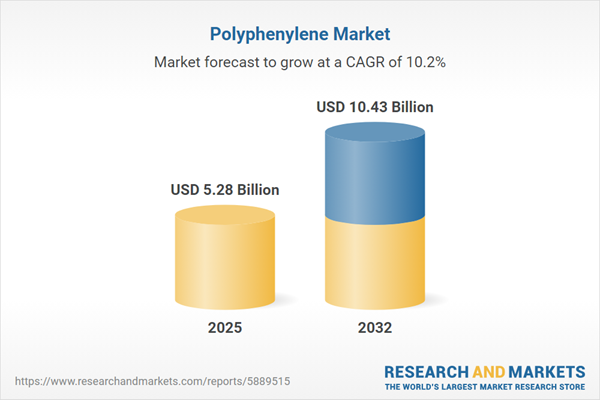Speak directly to the analyst to clarify any post sales queries you may have.
Senior decision-makers in the polyphenylene market must navigate a dynamic environment where innovation, compliance, and changing industry requirements intersect. Modern strategies require agility, risk management, and a clear view of where growth opportunities are emerging, particularly in technology-intensive and regulatory-driven sectors.
Polyphenylene Market Snapshot
The polyphenylene market is experiencing robust growth, with revenue expanding from USD 4.79 billion in 2024 to USD 5.28 billion in 2025, and projections reaching USD 10.43 billion by 2032 at a consistent CAGR of 10.20%. As high-performance polymers gain prominence across global industries, polyphenylene remains essential for meeting next-generation needs in automotive, electronics, consumer products, and industrial engineering. Its unique positioning at the intersection of regulatory compliance and advanced technical requirements makes it a material of choice for enterprises prioritizing durability, reliability, and future-ready supply chains.
Scope & Segmentation: Polyphenylene Market
This comprehensive report delivers actionable market segmentation and detailed insights, helping leaders prioritize investments while aligning with sector-specific demands and emerging opportunities.
- Application Areas: Polyphenylene is integral to automotive component manufacturing, such as electrical systems and both interior and exterior parts. It is widely used in consumer goods, including appliances, personal care products, and sports equipment. In the electrical and electronics sectors, the polymer advances connector reliability, insulation, switches, and relays. The industrial segment benefits from polyphenylene’s durability in seals, bearings, and chemical process applications, addressing reliability in high-stress environments.
- Material Types: Options like copolymer, polyphenylene ether, and polyphenylene sulfide allow manufacturers to match mechanical and thermal needs, optimizing materials for each product’s required performance profile.
- End Use Industries: Major sectors leveraging polyphenylene include automotive, consumer products, healthcare, electronics, and heavy industry, with each prioritizing the material for its longevity and performance versatility.
- Forms: Available as films, granules, and powders, polyphenylene accommodates diverse manufacturing processes, supporting both prototyping and mass production through various molding and extrusion techniques.
- Distribution Channels: Manufacturers access polyphenylene through direct sales, distributor and wholesaler networks, and expanding online channels, ensuring flexibility in sourcing strategies for established firms and market entrants.
- Grade Levels: Standard, high performance, and ultra high performance product grades enable precise material selection to address complex technical or regulatory requirements across applications.
- Regional Coverage: Market analysis spans the Americas, Europe, Middle East & Africa, and Asia-Pacific, with dedicated insights into growth trends in China, India, and the United States, supporting strategic planning for geographic expansion and risk mitigation.
- Companies Analyzed: Strategic benchmarking evaluates Solvay SA, DIC Corporation, Celanese Corporation, Teijin Limited, Sumitomo Chemical Co., Ltd., Toray Industries, Inc., Polyplastics Co., Ltd., Kureha Corporation, Asahi Kasei Corporation, and SK Chemicals Co., Ltd., offering a clear view of innovation strategies and competitive positions.
Key Takeaways for Senior Decision-Makers
- Polyphenylene adoption continues to rise in mainstream automotive and electronics, underlining its effectiveness in supporting next-generation designs and accelerating product development cycles.
- Advancements in copolymer technology and novel processing approaches give manufacturers the flexibility to respond to complex supply challenges and evolving technical demands.
- Supply chain digitalization enhances responsiveness, enabling companies to keep pace with regulatory changes and unpredictable market shifts while reducing operational friction.
- Sustainability is shaping operational strategy, with new recycling programs and bio-based alternatives fostering responsible sourcing and long-term risk management.
- Cross-industry collaborations, particularly among manufacturers, technology partners, and research bodies, are speeding up breakthroughs in electric mobility and broadening polyphenylene's impact across fast-growing regions like Asia-Pacific.
Tariff Impact & Competitive Dynamics
The 2025 introduction of US tariffs has shifted sourcing models, prompting more localized production, agile inventory management, and expanded partnerships among suppliers. These adjustments have heightened the involvement of North American suppliers and fostered alliances that support cost control and market responsiveness. Senior executives now view coordinated supply networks as fundamental when planning in a landscape defined by evolving trade policies and increasing competition.
Methodology & Data Sources
This report draws on direct senior leadership interviews, expert input from polymer scientists, legislative research, and comprehensive competitor benchmarking. Scenario analysis and data triangulation ensure the findings meet the standards required for leadership decisions influencing the entire polyphenylene value chain.
Why This Report Matters
- Helps senior executives make confident choices about resource allocation and adapt market strategies in response to ongoing polyphenylene market developments.
- Identifies and clarifies high-potential opportunities, empowering business leaders to manage risk, guide investments, and respond to emerging market needs.
- Presents reliable intelligence on evolving technologies and policy shifts, enabling fast, strategic responses for organizations pursuing growth in this sector.
Conclusion
Success in the polyphenylene market requires flexible strategy and a focus on technology-driven advancement. This report equips executive teams with industry evidence to support informed, future-focused decisions.
Additional Product Information:
- Purchase of this report includes 1 year online access with quarterly updates.
- This report can be updated on request. Please contact our Customer Experience team using the Ask a Question widget on our website.
Table of Contents
3. Executive Summary
4. Market Overview
7. Cumulative Impact of Artificial Intelligence 2025
List of Figures
Samples

LOADING...
Companies Mentioned
The key companies profiled in this Polyphenylene market report include:- Solvay SA
- DIC Corporation
- Celanese Corporation
- Teijin Limited
- Sumitomo Chemical Co., Ltd.
- Toray Industries, Inc.
- Polyplastics Co., Ltd.
- Kureha Corporation
- Asahi Kasei Corporation
- SK Chemicals Co., Ltd.
Table Information
| Report Attribute | Details |
|---|---|
| No. of Pages | 191 |
| Published | October 2025 |
| Forecast Period | 2025 - 2032 |
| Estimated Market Value ( USD | $ 5.28 Billion |
| Forecasted Market Value ( USD | $ 10.43 Billion |
| Compound Annual Growth Rate | 10.2% |
| Regions Covered | Global |
| No. of Companies Mentioned | 11 |









